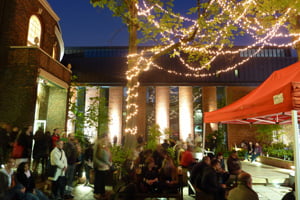Collective voice and collective will
Richard Nutter explains how a consortium of Liverpool’s major cultural organisations has developed a comprehensive strategic approach that places the arts and culture at the heart of the city’s social agendas

Collaboration in the arts and cultural sector has a long history in Liverpool but was formalised through the creation of the Liverpool Arts Regeneration Consortium (LARC) in the run up to the city’s year as European Capital of Culture in 2008. LARC is a strategic partnership of seven of Liverpool’s major arts and culture institutions – the Royal Liverpool Philharmonic, Tate Liverpool, Liverpool Biennial, Liverpool Everyman and Playhouse, National Museums Liverpool, FACT, the Bluecoat and Unity Theatre. The group is committed to creating a radical model in which an entire city region harnesses the power of arts and culture to influence the lives of thousands of local people and the communities in which they live.
The CEOs of the LARC organisations meet regularly (every other week) and the regularity of, and consistent representation at, the meetings has been the significant factor in ensuring the success of the consortium. “European Capital of Culture clearly demonstrated the role that culture could play in shaping the renaissance of Liverpool,” says Michael Eakin, Chief Executive of Liverpool Philharmonic. “As a result, partnerships have been strengthened with Liverpool City Council, the main tourism and economic development agencies, the city’s health sector, universities, colleges and the business community, recognising the critical importance of the sector to the city’s economic and social prosperity. The major arts and cultural organisations too are clear on their role in tackling the economic and social challenges that exist in the City, through for example, their learning programmes. This mutual recognition and understanding has been the key to successful influencing.”
Sally Tallant, recently appointed Chief Executive of Liverpool Biennial, sees great value in LARC organisations speaking with one voice: “Liverpool Biennial’s international position grew out of a collaborative vision to commission and present great art in a great city, so I was expecting a great deal of cooperation and collaboration when I moved here. However, the reach, impact and integration of the cultural sector throughout the city have surprised me. The sustained involvement by a consistent number of people means that there is a genuine collaborative agenda which hasn’t been developed at the expense of individual organisational objectives, but instead adds value and plays to individual strengths.”
Cultural leaders have become members of influential groups, agencies and forums in areas as diverse as health and wellbeing, education, transport, physical regeneration, economic regeneration, promoting investor confidence and the visitor economy. Senior management from Liverpool City Council are regular attenders at LARC meetings. LARC representatives sit on the Task Force that is developing the strategic One Plan for Liverpool and the Task Force overseeing the delivery of Liverpool’s Decade of Health and Wellbeing. The arts and culture have thus become key drivers in Liverpool’s business plans for regeneration, tourism and health and wellbeing.
Although this influence has been achieved through commitment and a collective voice, it has also been made possible by the ability to demonstrate impact. In 2008 LARC was awarded funding from Arts Council England (through the ‘Thrive’ programme) to support collaborative working and these resources have been used to build a collective evidence base. The large-scale economic and intrinsic impact studies undertaken by LARC would not have been affordable or deliverable by a single organisation and, more importantly, would not have been credible without the involvement of a wide range of arts and cultural organisations.
These studies demonstrated the significant impact of the Capital of Culture year – 9.7 million additional visits to Liverpool, generating a direct economic impact of £753.8m of additional visitor spend in the region. More recently, the Gross Value Added (GVA) study, demonstrated that the arts sector contributes £85m towards Liverpool’s total GVA – at 1% of total GVA this is greater than the contribution of the ICT sector (0.85%) – and that every £1 of local public money invested generates a GVA return of £11.14 in Liverpool City Region.
Michael Eakin adds: “We are benefiting from this influence and involvement and by being able to credibly demonstrate that we are major, growing businesses in our own right and a vital part of the cultural, economic and social fabric of Liverpool. Funding for culture from Liverpool City Council has been maintained at roughly the level of previous years, in spite of severe budget pressures.
“Liverpool Primary Care Trust has been a significant funder of LARC organisations’ artistic and learning programmes aimed at improving health and wellbeing, including current funding for a major Artist in Residence programme.”
Liverpool has been transformed in the past decade, the result of a major regeneration programme delivered by innovative public and private sector partnerships. Key amongst these partnerships has been LARC and the fact that this influence has been maintained in a changing political landscape is testament to the power of a collaborative approach. With a collective voice and a collective will, the arts are capable of shaping the strategic growth of a major city.
Join the Discussion
You must be logged in to post a comment.